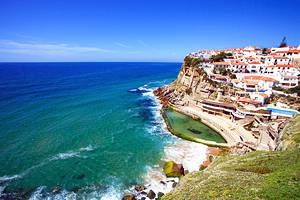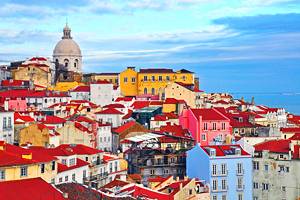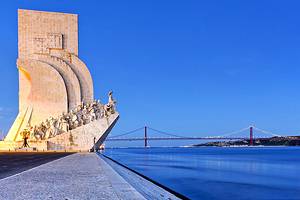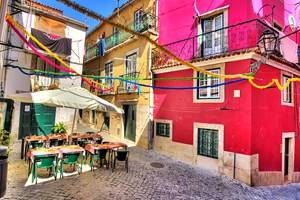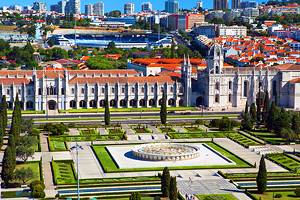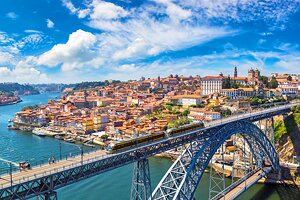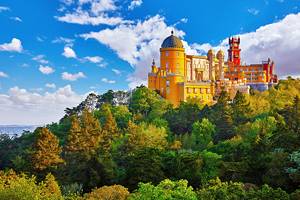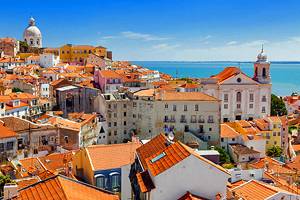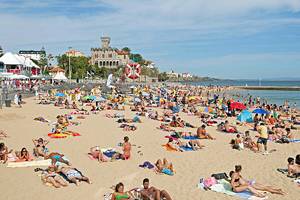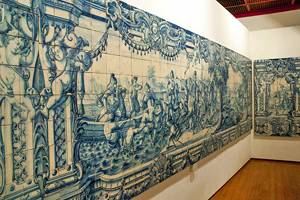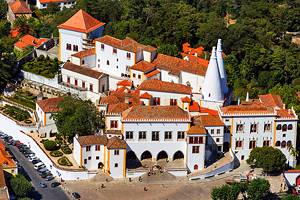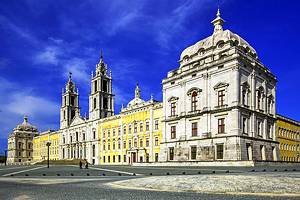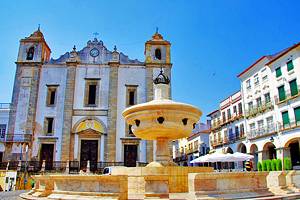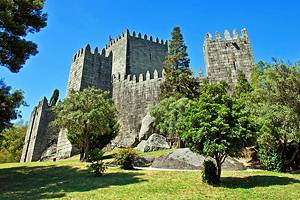Visiting Torre de Belém: Attractions
Standing on the waterfront at Belém, near the mouth of the River Tagus, is the Torre de Belém, arguably the most iconic symbol of Lisbon. Originally conceived as a lighthouse, the tower was eventually built as a defensive fortress on the orders of King Manuel I.
Architect Francisco de Arruda was tasked with designing the tower. Based in Évora and hailing from a long and illustrious line of royal surveyors and builders, de Arruda had worked on the nearby Mosteiro dos Jerónimos with his brother Diogo and similarly wrapped his new creation in a wealth of Manueline symbolism: highly decorative, carved stone maritime motifs including twisted rope and the Cross of the Order of Christ.

North African and Italian architectural influences are also apparent. When it was inaugurated in 1521, the tower would have been much farther from the shore than it is today - the earthquake of 1755 shifted the river's course, and in the 19th century, land on the north bank was reclaimed, making the river narrower.
Granted World Heritage status by UNESCO in 1983, the Belém Tower is today one of the most popular tourist attractions in Lisbon. Reached by a narrow walkway from Belém's broad esplanade, this quirky Manueline gem is a delight to explore.
Kids, especially, will have endless fun playing hide and seek among the parapets, or scampering up and down the narrow spiral staircases. The rest of us, meanwhile, can contemplate the achievements of Portugal's bravest navigators, who departed near this historic landmark to chart unknown lands 500 years ago.
Exterior

One of Lisbon's most iconic buildings, the Tower of Belém typifies the Manueline style of architecture that is symbolic of Portugal's great era of expansion.
Constructed on a hexagonal floor plan, the four-story tower was created in the shape of a ship's bow jutting into the water. The main façade of the fortress faces the sea and offers a completely different impression of the tower from that enjoyed along the riverbank.
Built from ivory-white limestone, the real beauty of the structure lies in the decoration of the exterior. Embrasures have been incorporated into the walls of the lower bastion, and the distinctive battlements are shaped in the form of shields embellished with the Cross of the Order of Christ.
The same ornate filigree decorates the external walls of the square tower, where carved stone armillary spheres and nautical rope - symbols of Portugal's seafaring prowess - embellish the windows and arches. Dinky onion-domed Moorish-style sentry posts accentuate each corner of the terrace, while another four turrets surround the top terrace.
The tower's outstanding feature, the beautiful arcaded Renaissance loggia, graces the south façade, so it cannot be seen from the shore - enticement enough to tread the gangway and visit this graceful Manueline sea fort, a mini masterpiece of military architecture.
Lower Battery

Commence your self-guided tour of the tower by investigating the lower battery, also known as the bulwark. Set under a graceful web of vaulted ceilings, it houses the tower's artillery - 17 cannons aimed towards the approaches to the mouth of the River Tagus.
Under the nave of the bulwark, deep in the bowels of the building below the waterline, are a number of magazines. This isolated area was an appropriate place for storing gunpowder and military equipment. It later served as a dungeon, and was used as a prison right up until the 19th century.
The arched portal leading into the room is so low that you practically have to double up in order to enter. A single skylight carved out of the roof offers the only glimpse of the outside world.
And if you're wondering - the marble tablet displayed near the entrance explains the waiver of taxes granted by the king to all Portuguese ships passing the fortress when entering and leaving the harbor, but reminds foreign vessels of a port fee levied when departing Lisbon. It's dated 19 January, 1655.
The Governor's Chamber

A perilously steep and narrow spiral staircase leads to the tower's first level and the governor's chamber. The room served as the duty office for the Governor of Belém (his official residence was an onshore palace, now a nearby hotel). Between 1517 and 1834, nine successive governors lived and worked in these spartan quarters.
Today, the chamber is bereft of furnishings save for the octagonal opening to a cistern that collected and stored rainwater. At the northeast and northwest corners of the room, you can squeeze through the skinny tunnels that lead to the bartizans - the overhanging, wall-mounted turrets that protrude from the tower's exterior walls.
From the northwestern turret, you can spy the small stone rhinoceros' head visible below the roped belt of the tower. The unusual carving is supposed to commemorate a rhinoceros that King Manuel I received as a gift from India - the first rhino ever seen in Europe.
The King's Chamber

The staircase continues to spiral upwards to the second level, where you are regaled with the king's chamber. This is the most interesting room in the tower because it leads onto a balcony, an elegant Renaissance loggia, inspired by Italian architecture. Here, you can gaze down onto the tower's lower terrace and take in the sweeping river panorama. Look for the eight round holes in the floor, known as machicolations, through which the garrison's defenders could drop stones or other objects to fend off attacks.
The room itself is unremarkable, except for an impressive stone fireplace with a mantelpiece adorned with decorative armillary spheres set in the northwest corner.
Audience Chamber and the Chapel

The audience chamber and the chapel are found on the tower's third and fourth levels respectively. There's little in the audience chamber to distract you. However, the chapel has been converted into a small auditorium where a short video presentation broadcasts the history surrounding the monument and the Discoveries. The illustrated information panels on the walls offer further enlightenment.
Tower Terrace

The claustrophobic climb to the top of Torre de Belém is rewarded with a wide-open panorama of the River Tagus and the waterfront. Clearly visible to the east is the Padrão dos Descobrimentos and in the distance, the Ponte 25 de Abril suspension bridge.
The vista north leads the eye all the way to the top of Avenida da Torre de Belém and, peeping through the trees, the tiny Ermida de São Jerónimos, a charming, but rarely visited chapel built by Diogo de Boitaca in 1514, one of the architects responsible for building the Mosteiro dos Jerónimos.
Upper Battery

After you've soaked in the river views, make your way back downstairs to conclude your tour on the upper battery. This area provided the tower with a second level for the firing of artillery and is where the drawbridge would have been raised and lowered.
It's from the terrace that the south façade can best be admired. The royal coat of arms of Manuel I is clearly visible, set in stone above the loggia. The decorative parapet surrounding the open space of the patio is surmounted by a fine Gothic statue of the Virgin Mary and Child - Our Lady of Safe Homecoming, a symbol of protection for sailors on their voyages of discovery.
Another set of watchtowers jutting from the walls usually proves irresistible to tourists seeking a final photo opportunity.
Address
- Avenida da Brasília, Belem, Lisbon, Portugal 1400-038
- www.torrebelem.pt
Lisbon - Climate Chart
| Average minimum and maximum temperatures for Lisbon, Portugal in °C | |||||||||||
| J | F | M | A | M | J | J | A | S | O | N | D |
| 15 8 | 16 9 | 18 10 | 19 11 | 22 13 | 25 16 | 27 17 | 28 18 | 26 17 | 22 15 | 18 11 | 15 9 |
| PlanetWare.com | |||||||||||
| Average monthly precipitation totals for Lisbon, Portugal in mm. | |||||||||||
| 109 | 112 | 69 | 64 | 38 | 20 | 5 | 5 | 25 | 81 | 114 | 109 |
| Average minimum and maximum temperatures for Lisbon, Portugal in °F | |||||||||||
| J | F | M | A | M | J | J | A | S | O | N | D |
| 58 46 | 60 48 | 63 49 | 66 52 | 71 55 | 76 60 | 81 63 | 82 63 | 79 62 | 72 58 | 64 52 | 58 48 |
| PlanetWare.com | |||||||||||
| Average monthly precipitation totals for Lisbon, Portugal in inches. | |||||||||||
| 4.3 | 4.4 | 2.7 | 2.5 | 1.5 | 0.8 | 0.2 | 0.2 | 1.0 | 3.2 | 4.5 | 4.3 |
More Related Articles on PlanetWare.com
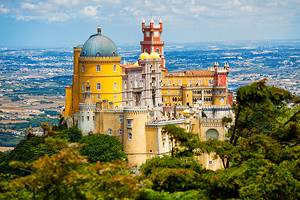
Near Lisbon: Torre de Belém is among the top tourist attractions in Portugal and a cultural treat for anyone interested in history and architecture. Another must-see for those drawn to the country's heritage is the Mosteiro dos Jerónimos nearby and the Museu Nacional do Azulejo-Convento da Madre de Deus, located on the city's eastern outskirts. North of the capital is Palácio Nacional de Sintra, also distinguished by UNESCO and situated in a region easily reached as part of a day trip from Lisbon.



